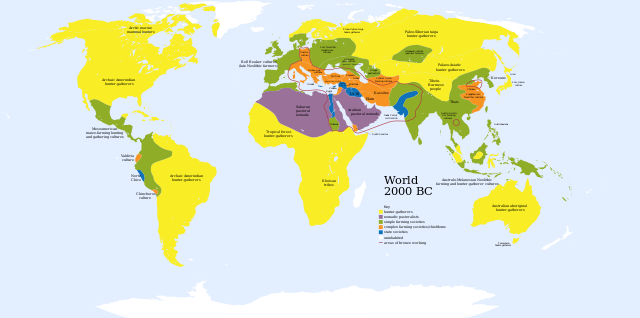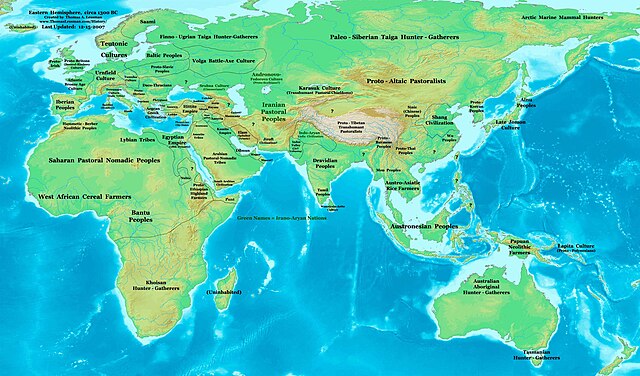Top Qs
Timeline
Chat
Perspective
Outline of ancient India
From Wikipedia, the free encyclopedia
Remove ads
The following outline is provided as an overview of and topical guide to ancient India:

Ancient India is the Indian subcontinent from prehistoric times to the start of Medieval India, which is typically dated (when the term is still used) to the end of the Gupta Empire around 500 CE.[1]
General history of Ancient India
Summarize
Perspective
An elaborate periodisation may be as follows:[2]
Pre-history (Neolithic Age) (c. 8000–3500 BCE)
- Indian Pre-history Age (c. 10,000–3300 BCE)
- Bhirrana culture (7570–6200 BCE)
- Mehrgarh culture (c. 7000 – c. 2500 BCE)
Proto-history (Bronze Age) (c. 3500–1800 BCE)

- Indus Valley Civilisation (c. 3300 – c. 1300 BCE), including the "first urbanisation"
- Ahar–Banas culture (c. 3000 – c. 1500 BCE)
- Ochre Coloured Pottery culture (c. 2600–1200 BCE)[3]
- Cemetery H culture (c. 1900–1300 BCE)[4]
Iron Age (c. 1800–200 BCE)

- Iron Age India (c. 1800 – c. 200 BCE)
- Vedic civilization (c. 1700 – c. 600 BCE)
- Black and red ware culture (c. 1500–700 BCE) in Western Ganges plain[5]
- Northern Black Polished Ware (c. 1200–500 BCE)[6]
- Painted Grey Ware culture (c. 1200 or 700–300 BCE)[7]
- Brihadratha dynasty (c. 1700 – c. 682 BCE)
- Gandhara Kingdom (c. 1500 – c. 545 BCE)
- Kuru kingdom (c. 1200 – c. 345 BCE)
- Indian Iron Age kingdoms (c. 600 – c. 345 BCE)[8]
- Pandyan Kingdom (c. 600 BCE – c. 650 CE)[9]
- Vedic civilization (c. 1700 – c. 600 BCE)
Pre-Classical Period (c. 600 BCE–200 CE)


- Pradyota dynasty (c. 682–544 BCE)
- Haryanka dynasty (c. 544–413 BCE)
- Shaishunaga dynasty (c. 413–345 BCE)
- Nanda Empire (c. 345 – c. 322 BCE)
- Maurya Empire (c. 322–185 BCE)
- Sangam period (c. 300 BCE – c. 300 CE)
- Pandyan Kingdom (c. 600 BCE–1650 CE)
- Chera Kingdom (c. 300 BCE–1102 CE)
- Chola Kingdom (c. 300 BCE–1279 CE)
- Kalinga Empire (until 250 BCE)
- Maha-Megha-Vahana Empire (c. 2600–300 CE)
- Satavahana Empire (230 BCE–220 CE)
- Kuninda Kingdom (c. 2600–350 CE)
- Shunga Empire (c. 185–73 BCE)
- Kanva dynasty (c. 73–26 BCE)
- Indo-Greek Kingdom (180 BCE–10 CE
- Kushan Empire (30–375 CE)
- Indo-Scythian Kingdom ( c. 12 BCE–395 CE)
Classical Period (c. 200–550 CE)

There are varying definitions of this period.[note 1]
- Gupta Empire (c. 320–650 CE)
- Later Gupta dynasty (c. 490–750 CE)
- Vakataka Empire (c. 250 – c. 500 CE)
- Pallava Empire (c. 275–901 CE)
- Kadamba dynasty (c. 345–1347 CE)
- Western Ganga dynasty (c. 350–1024 CE)
- Vishnukundina Empire (c. 420–624 CE)
- Maitraka dynasty (c. 475 – c. 776 CE)
- Rai dynasty (c. 489–632 CE)
Remove ads
Culture in ancient India
Art in ancient India
Languages in ancient India
Religion in ancient India
Science and technology in ancient India
Organisations concerned with ancient India
Museums with ancient Indian exhibits
- India (clockwise)
- United Kingdom
- British Museum, London
Notes
- Different periods are designated as "classical Hinduism":
- Smart calls the period between 1000 BCE and 100 CE "pre-classical". It is the formative period for the Upanishads and Brahmanism[subnote 1] Jainism and Buddhism. For Smart, the "classical period" lasts from 100 to 1000 CE, and coincides with the flowering of "classical Hinduism" and the flowering and deterioration of Mahayana-buddhism in India.[11]
- For Michaels, the period between 500 BCE and 200 BCE is a time of "Ascetic reformism",[12] whereas the period between 200 BCE and 1100 CE is the time of "classical Hinduism", since there is "a turning point between the Vedic religion and Hindu religions".[13]
- Muesse discerns a longer period of change, namely between 800 BCE and 200 BCE, which he calls the "Classical Period". According to Muesse, some of the fundamental concepts of Hinduism, namely karma, reincarnation and "personal enlightenment and transformation", which did not exist in the Vedic religion, developed in this time.[14]
- Subnotes
Remove ads
References
Sources
External links
Wikiwand - on
Seamless Wikipedia browsing. On steroids.
Remove ads
